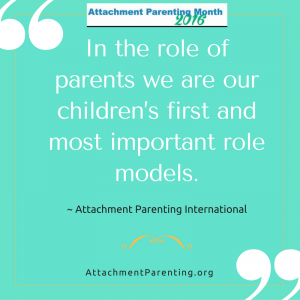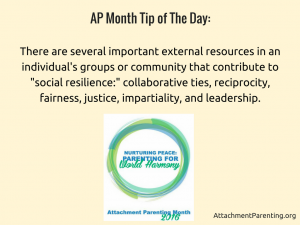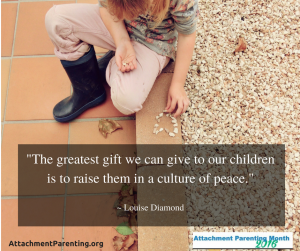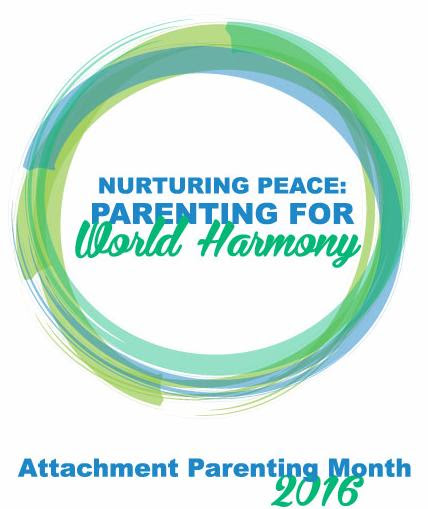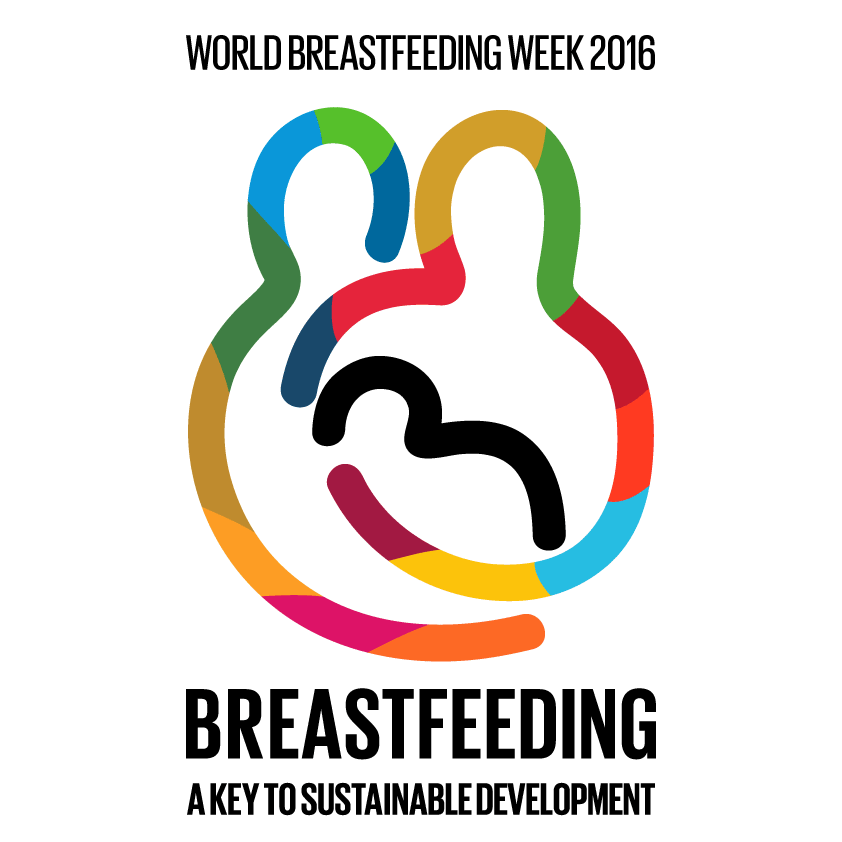Category: Strive for Balance
Daily tip: 6 traits of a positive community
The greatest gift…
What is going on behind closed doors?
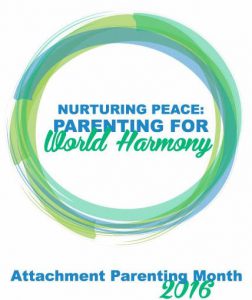 We, as a society, have to change the way we live.
We, as a society, have to change the way we live.
It’s just that simple, and just that hard.
We are shocked nearly every day by news of another seemingly senseless, violent act. We have names for the big ones — Columbine, Sandy Hook, Omaha mall shooting, Dallas — helping us remember the victims and helping us process the overwhelm of confusion, sadness, anger, and the inexplicable that we felt when we found out. It’s getting harder to name these shootings, stabbings, even bombings — there’s just too many of them, happening too frequently, and worse of all, it’s becoming almost commonplace to hear about them. We are desensitizing.
Except for in war, or in other chronically unsettled parts of the world, there seemed to be a long period of time when we just didn’t hear of these types of events happening to Americans. Perhaps there were more acts of violence in schools, workplaces, and communities before Columbine in 1999 and the news at the time just didn’t pick up on them?
But I have a different theory. Our culture has changed. Society is far less accepting of violent tendencies. We are appalled to hear stories of domestic violence in homes, and rightly so. No one deserves to live in an unsafe home. We all have dignity, and women should be treated as equals to men. We are working toward more nurturing relationships and positive discipline toward our children. Fewer teachers are allowed to harshly treat students that frustrate them. Overall, we cannot go around instilling fear in one another as an every day part of life. As it should be.
Except that while there are these widespread expectations to treat one another with respect, there has been less available instruction in how to do that. There is so much more support today for parents, teachers, couples, employers, and others traditionally in positions of authority in relationships. And we, as a society, are finding ways to transcend the existing gaps at a rapid pace, with such ideas as mindfulness in schools rather than issuing detention and offering free positive discipline education at local API Support Groups.
But there was a gap of widespread support that spanned at least 1 generation. From the time when the Columbine school shooting rocketed through the news, to now when cry-it-out sleep training is being openly debated rather than just merely accepted as the norm — reflecting the huge change we, as a culture, are having on the idea of relationship — there was 1 or 2 generations of individuals who were transitioning from the “old” way of relating — hierarchical and fear-based authority — to this “new” way: collaborative, emotionally literate, and focused on problem-solving. That’s a big leap from the old to the new way, and all leaps need support to bridge the gap.
We are steadily closing that gap. Nurturing parenting and related practices — like mindfulness, emotion coaching, collaborative work environments, healthy conflict resolution, nonviolent communication, overall questioning the status quo — are coming from all directions, not only from Attachment Parenting International (API) but also schools, workplaces, health care providers, community leaders, and other major sectors of society. We’re getting ideas we can put into practice at work, home, on the road, and even in the grocery store about how we can relate to one another better and resolve disagreements peacefully. This idea of living together as a nurturing community is becoming holistic.
But still we hear of these awful incidents of kids killing kids, coworkers killing coworkers, strangers killing strangers. If we thought Columbine was confusing, what do we think now as our cultural acceptance of nurturing and peaceful conflict resolution is taking hold. If this doesn’t work, what will?
We then go on to blame the news media, access to guns, leniency in sentencing, racism, politics, mental illness, and so on. The truth is, these big problem areas — like violence in society — are much bigger than a single factor, or even a few factors. It is difficult to unravel the causes, because the factors that contribute to each one seem different and ever-shifting.
The undertone to all of these is that the perpetrator in each case saw violence to be his or her best opportunity at the moment. It might have been a last resort in many cases, but it was the best option of what was left in that person’s mind. Exactly why that was the best option at the time, we probably will never know. We can speculate, but that’s only as good as guessing.
 But we do know that violence has to be planted in a person’s mind as an acceptable option, in whatever situation. Babies aren’t born violent. They are born wired to seek connection. People have to learn violence, which begins as disconnection. They learn to detach as a survival mechanism when their needs aren’t meant. There are various degrees of this, as we see in insecure attachment research, and definitely few insecurely attached children grow up to choose violence that makes the news. But that detachment is the first step to accepting violence as an option at all.
But we do know that violence has to be planted in a person’s mind as an acceptable option, in whatever situation. Babies aren’t born violent. They are born wired to seek connection. People have to learn violence, which begins as disconnection. They learn to detach as a survival mechanism when their needs aren’t meant. There are various degrees of this, as we see in insecure attachment research, and definitely few insecurely attached children grow up to choose violence that makes the news. But that detachment is the first step to accepting violence as an option at all.
I believe that we, as individuals, are not inherently violent but that it is learned. If it were so that we are innately violent, we could not be moving toward a more nurturing culture as we are.
 But our culture does have its leftovers from previous generations’ perspectives on relationship, and those leftovers are most often seen — not in the news of mass killings that we are increasingly seeing — but more in our homes, behind closed doors, when conflict arises between couples and between parents and children. Those leftovers are there when parents yell at, emotionally withdraw, or strike their children in the name of “discipline.” Those leftovers are there when babies begin life with crying it out, learning that their biological need for connection will be ignored.
But our culture does have its leftovers from previous generations’ perspectives on relationship, and those leftovers are most often seen — not in the news of mass killings that we are increasingly seeing — but more in our homes, behind closed doors, when conflict arises between couples and between parents and children. Those leftovers are there when parents yell at, emotionally withdraw, or strike their children in the name of “discipline.” Those leftovers are there when babies begin life with crying it out, learning that their biological need for connection will be ignored.
There are so many contributing factors to societal violence, but it all does start in the home — with what our children grow up with, learning what is “normal” and what is expected, learning how to “resolve” disagreements and “calm” strong emotions like frustration or disappointment…whether peacefully or with force.
We have to change the way we live, in all areas of our lives, beyond but especially behind closed doors, in order to nurture peace and live in world harmony.
Join us, starting October 1, as API explores this theme through Attachment Parenting Month. World peace begins with peace in the home.
We are parents: We are all in the business of world peace.
Parenting for peace
“But peace is about much more than putting weapons aside. It is about building a global society in which people live free from poverty and share the benefits of prosperity. It is about growing together and supporting each other as a universal family.” ~ Ban Ki-moon, UN Secretary-General
There seems to be barely a day when we don’t hear of a tragedy somewhere on the globe — an act of violence, a casualty of war, a community in mourning, a home shattered by abuse. Where is peace?
Peace in our world, our nations, our communities, our homes, ourselves — we all want it, but it can seem unattainable in the societies where we live. Or is it?
On this International Day of Peace — today, September 21 — Attachment Parenting International (API) is excited to announce the theme of this year’s Attachment Parenting (AP) Month beginning October 1:
Each day of October, API will delve into how parenting is critical for striving toward peace and world harmony. We will renew our support for the ultimate peacemakers — you, the parent.
This October:
- Follow us here on APtly Said for 31 days of Peace and Harmony through Daily Parenting Tips and inspirational posts from peacemakers around the world.
- Add your family to our Wall of Harmony.
- Submit a post, however short or long, on what “parenting for peace” means to you to be published on APtly Said during AP Month.
- Donate items to our online auction, running October 18-31.
- Keep in touch and share AP Month with friends on Facebook.
WBW 2016: 5 tips for a strong nursing relationship while working away from home
Editor’s note: Among the 17 Sustainable Development Goals central to World Breastfeeding Week this year is a call for better workplace support of breastfeeding women. Certainly employers have a large part to play in meeting this goal, but women also need step up to advocate for themselves, their babies, and their right to express breastmilk while at work:
It’s that day…the dreaded day that no new mother wants to face — the last day of maternity leave.
For a mother able to take 12 weeks of unpaid leave afforded by the Family & Medical Leave Act, the last 3 months in baby bliss may instead feel like 3 short weeks, but regardless of the maternity leave length, the end of that special period arouses many emotions, especially for a nursing mother.
Naturally, a nursing mother’s mind becomes occupied with fears and questions:
- How will I be able to provide enough milk while I am away?
- What if my baby refuses a bottle?
- Where will I find enough time to pump while I’m trying to work?
- How will my boss and coworkers feel when I need time to pump?
- What will happen to our nursing relationship?
This uncertainty creates even more stress and anxiety for the breastfeeding and working-away-from-home mother for she knows the important role breastfeeding plays in a secure attachment in addition to the numerous health benefits.
 Continued nursing after the maternity leave period helps maintain a strong attachment between mother and baby. In his book, The Attachment Parenting Book, Dr. William Sears includes a chapter entitled “Working and Staying Attached,” in which he points out that giving your baby your milk is a very important way of staying attached to your baby after returning to work. Expressing milk for baby to drink during the day allows mother to, in a sense, be with baby while she is away at work. When mother and baby are reunited, their attachment through breastfeeding can resume as if she never left.
Continued nursing after the maternity leave period helps maintain a strong attachment between mother and baby. In his book, The Attachment Parenting Book, Dr. William Sears includes a chapter entitled “Working and Staying Attached,” in which he points out that giving your baby your milk is a very important way of staying attached to your baby after returning to work. Expressing milk for baby to drink during the day allows mother to, in a sense, be with baby while she is away at work. When mother and baby are reunited, their attachment through breastfeeding can resume as if she never left.
Nursing beyond maternity leave not only helps strengthen attachment but also provides numerous health benefits for the nursing mother and her nursling. In 2012, The American Academy of Pediatrics (AAP) published their policy statement, “Breastfeeding and the Use of Human Milk,” in Pediatrics. In this document, the AAP notes the numerous benefits of nursing, including those of nursing beyond 3-4 months. Some of these benefits for baby include a lower risk for developing serious colds, asthma, and other allergies; Sudden Infant Death Syndrome; and childhood and adult obesity. For the nursing mother, benefits include a lower risk of diabetes for mothers not diagnosed with gestational diabetes, a lower chance of arthritis, and breast and ovarian cancers. Essentially, the longer a mother can provide her baby with mother’s milk, the more health benefits received by both mother and baby.
In order to continue a secure attachment and experience the health benefits of breastfeeding, nursing mothers can maintain a strong nursing relationship while working away from home by following a few simple tips:
- Know your breastfeeding rights — Under the Patient Protection and Affordable Care Act, many U.S. employers must provide a nursing mother with break time and a place to pump for up to 1 year after the birth of her baby. It is to be noted that companies with less than 50 employees are exempt from this law and instead offer pumping breaks at the discretion of the employer. Information, along with instructions for filing a complaint, can be found through the United States Department of Labor. Many other countries have generous allowances for nursing mothers at work, so be sure to check with your nation’s laws.
- Plan a pumping schedule — This schedule will differ from mother to mother. Planning to nurse right before being separated from baby and as soon as mother and baby are reunited can help reduce the amount of pumping sessions needed at work. While at work, a mother should try to pump about every 3-4 hours. For a mom working an 8-hour shift, she might pump once in the morning, once during her lunch, and once in the afternoon. The idea is that for each time baby receives expressed milk from his or her care provider, mother is pumping. In doing this, mother should be able to pump the amount of milk that baby will consume the following day. Talk with a local breastfeeding specialist for a pumping schedule tailored to your work environment and other needs.
- Discuss needed accommodations with employer — When a mother meets with her employer, she should be prepared by knowing her legal rights. A working-away-from- home mother should inform her employer of the needed accommodations before returning to work. The employer may need some time to make changes in order to accommodate the nursing mother. When the mother meets with her employer, she should provide her employer with a copy of her nursing schedule. This may also include pumping space accommodations. For example, the room where milk will be expressed needs to have an easy-to-access electrical outlet and should be heated and cooled.
- Nurse on demand — Although a working mother must have a pumping schedule while at work, at home, she can nurse her baby on demand. Nursing on demand means that a nursing mother nurses when cued by the baby. This might be every 30 minutes or every 2 hours. Since how much milk produced is based on demand, a nursling can help increase a mother’s supply by nursing frequently. Nursing on demand also allows baby to re-establish the nursing bond that was missed during the day. Nursing on demand can continue during the night. Frequent night nursing may lead to reverse cycling, meaning the baby will nurse more frequently during the night than he or she does during the day. Some mothers who encourage reverse-cycling find that they don’t need to pump as much while at work during the day. For example, a baby may only drink 4-5 ounces of milk while his or her mother is at work, but the remaining amount of milk needed will be attained during the evening and all through the night. Essentially, in 24 hours, the baby will have consumed his or her total amount of milk needed.
- Get support — Most nursing mothers need support throughout the breastfeeding journey, and nursing mothers that work away from home are no exception. La Leche League International and other nonprofit organizations provide local and online opportunities for mothers to connect and support each other.
While the end of maternity leave marks a transitional period for mother and baby, a strong nursing relationship can be maintained by carefully preparing for this changed and remaining dedicated to the desire to nourish baby with mother’s milk.
Reading between the lines, Part 3: Trusted Resources
Editor’s note: There are continually media reports coming out about parenting approaches, including Attachment Parenting. Some are affirming. Others are worrying. It’s important that we know how to read between the lines on media reports regarding Attachment Parenting so that we can make informed decisions. That’s why Attachment Parenting International compiled this sampling of trusted resources for parenting information, in addition to consumer media guidelines and additional guidelines for reading scientific studies:
FamiliesForConsciousLiving.org
Reading between the lines, Part 2: Get the Most Out of a Scientific Study
Editor’s note: There are continually media reports coming out about parenting approaches, including Attachment Parenting. Some are affirming. Others are worrying. It’s important that we know how to read between the lines on media reports regarding Attachment Parenting so that we can make informed decisions. That’s why Attachment Parenting International (API) created consumer media guidelines for parents. Here are additional guidelines specific to reading scientific studies:
 Unless you’re an academic, you’ll probably find research studies to not be the easiest material to digest, but if the science behind parenting matters to you, it’s important to check out studies you learn about through the media. Here are tips to help you skim through a study without getting bogged down in scientific terms:
Unless you’re an academic, you’ll probably find research studies to not be the easiest material to digest, but if the science behind parenting matters to you, it’s important to check out studies you learn about through the media. Here are tips to help you skim through a study without getting bogged down in scientific terms:
- Read the title. What does it predict?
- Read the abstract. This is the most complete synopsis of the paper. It will outline the highlights of the study but without the necessary emphasis to allow you to make a critical assessment of the results.
- Read the last or second-to-last paragraph of the Introduction. This gives you what the abstract does not. But if you’re not familiar with the work, read the entire Introduction and pick out issues to explore separately.
- Read the first, or sometimes the last, paragraph of the Discussion. By this point, you should be able to identify the hypotheses, know what type of results to expect, and have the predictions on the experiments and their outcomes.
- Examine each Figure or Table in sequence. Read the Results associated to each Figure or Table for clarification. For issues concerning methodology, refer to the appropriate point in the Materials and Methods.
- Does the experiment address the hypothesis? Does the experiment contribute to the stated conclusions? Is the experiment central to these conclusions? Or does it provide a control? Or does it repeat previous results? Or does it contribute little to the paper?
- How well did you predict the experiment and the results?
- As you evaluate the actual results — not just the stated results — in the Figures and Tables, ask yourself: Do the results support their claim with the appropriate controls to validate the results? Do you see more in their results that they fail to address or identify? Can you identify limitations to their results or the experimental approach? Do the results address the hypotheses that you have identified?
- After reading through the Results, you should be able to identify the single-most important Figure or Table in the paper.
- Read through the Discussion to weigh the stated conclusions and claims against the evidence. Do you agree or disagree?

